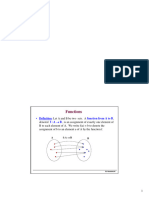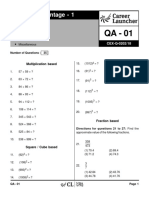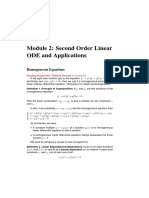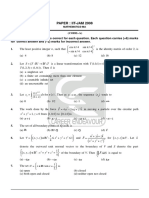Subjective & Injective Functions
Uploaded by
Mana GargiSubjective & Injective Functions
Uploaded by
Mana GargiQA – Subjective and Injective Function
SURBJECTIVE AND INJECTIVE FUNCTIONS
Function
Many one One one (or injective)
Many inputs produce Only one input produce any output
One output one output i.e., no two inputs produce same
Function
Into Onto (or subjective)
There is at least one Every element of B is necessarily
element of B which is an output (or image) of an element of A.
not the output (or image)
of any element of A.
One to One (or Injective) Function
A function f is said to be one-to-one if it does not have the same output for two distinct
values in its domain.
For example, f (x) = x3 is one to one whereas f (x) = x2 is not, as f (1) = 1 and f (-1) = 1
In order to show that a function f : A B is one-one we may take any x, y A such that f (x)
= f (y) and try to show that x = y.
Graphically , if every horizontal line intersects the graph of a given function at not more than
one point, i.e., the function is strictly increasing (or decreasing) then the function is one-
one.
Functions which are not one to one are called many-one function.
Proprietary and Confidential ABS Classes 1
QA – Subjective and Injective Function
One many function does not exist.
Onto (or Subjective Function)
If a function f : A B is such that each element in B is the output of at least one element in
A, then we say that f is function of A ‘onto’ B.
In order to show that a function f : A B is onto we start with any y B and try to find x
such that f (x) = y.
Bi-jective Function: If a function f is both one-to-one and onto then f is said to be a
bijective function e.g., an identity function is a bijective function.
INVERSE FUNCTION
Inverse of a function: If f:A B is a bijection, we can define a new function from B to A
which associates each element y B to its pre-image f-1 (y) A. Such a function is known as
the inverse of function f and is denoted by f-1.
Inverse of a function is defined if the function is one-to-one and onto.
In the inverse function inputs and outputs interchange their roles.
Inverse of a function is not defined if the given function is a many-one function or
into function or both.
If the graph of a function f (x) is symmetric about the line y = x, then f (x) and f-1 (x)
are identical function.
is the inverse function of
Summary:
1) One-to-one: A function f is one-to-one (injective), if & only if whenever f(x) = f(y), x = y i.e.
no two different input can give the same output.
Example: The function f(x) = x2, positive and negative values of x will give the same value of y. So it is
not one to one
2) Onto: A function f from a set A to a set B is onto (subjective), if and only if for every
element y of B , there is an element x in A such that f(x) = y , that is, f is onto if and only if
f( A ) = B .
Example: The function f(x) = 2x . A is a set of natural numbers and B is a set of even. So every elemnt
in B is an output of some element in A. Therefore it is an onto function
3) Bijection: A function is called a bijection, if it is both onto and one-to-one.
Example: The function f(x) = 2x . A is a set of natural numbers and B is a set of even. So every elemnt
in B is an output of some element in A. Therefore it is an onto function
Proprietary and Confidential ABS Classes 2
QA – Subjective and Injective Function
Also every element in A will give a distinct output in B. therefore it is an into function. Therefore it is
a bijection fuction,
Every bijection has a function called the inverse function.
Proprietary and Confidential ABS Classes 3
You might also like
- MATH3161/MATH5165 Optimization: The University of New South Wales School of Mathematics and StatisticsNo ratings yetMATH3161/MATH5165 Optimization: The University of New South Wales School of Mathematics and Statistics4 pages
- (REVISED) FUNCTION_0d1dbbee-8f97-4bec-8e21-511619d4afc8No ratings yet(REVISED) FUNCTION_0d1dbbee-8f97-4bec-8e21-511619d4afc85 pages
- TOPIC 2 - Functions and Equivalence Relation100% (1)TOPIC 2 - Functions and Equivalence Relation87 pages
- MATH 1302 - Unit 2 Discussion AssignmentNo ratings yetMATH 1302 - Unit 2 Discussion Assignment4 pages
- Function: Fernando Toding Bua' Ayu Andini Andry Yusdi Akidah Amaliah Jasrina Jumardi HasanNo ratings yetFunction: Fernando Toding Bua' Ayu Andini Andry Yusdi Akidah Amaliah Jasrina Jumardi Hasan19 pages
- XI - Maths - Chapter 2 - FUNCTIONS (11.03.2015) (1-57)No ratings yetXI - Maths - Chapter 2 - FUNCTIONS (11.03.2015) (1-57)58 pages
- Nama: Monika Basar Nim: 2017.V.1.0045 Mata Kuliah: Struktur AljabarNo ratings yetNama: Monika Basar Nim: 2017.V.1.0045 Mata Kuliah: Struktur Aljabar3 pages
- Composite Function Classification of FunctionNo ratings yetComposite Function Classification of Function12 pages
- 1.1: Functions: Reason: in Arrow Diagram (B), Domain A' Has Two100% (2)1.1: Functions: Reason: in Arrow Diagram (B), Domain A' Has Two12 pages
- Maths Xii Chapter 1 Relations and FunctionsNo ratings yetMaths Xii Chapter 1 Relations and Functions27 pages
- Chapter 1 Mathematics - Class 12 - Formula - SheetNo ratings yetChapter 1 Mathematics - Class 12 - Formula - Sheet3 pages
- ONTO, One To One and Injective FunctionsNo ratings yetONTO, One To One and Injective Functions13 pages
- One-Word Substitutes: Part 4: Sr. No. Phrase WordNo ratings yetOne-Word Substitutes: Part 4: Sr. No. Phrase Word18 pages
- Additional Mock Cat Varc Test-1 (Wiley Cat Varc Book)No ratings yetAdditional Mock Cat Varc Test-1 (Wiley Cat Varc Book)11 pages
- Word-Builders-Roots, Prefixes and SuffixesNo ratings yetWord-Builders-Roots, Prefixes and Suffixes16 pages
- QA Concept 8 - Indices & Surds Session 1No ratings yetQA Concept 8 - Indices & Surds Session 125 pages
- Joints: Revolute Joint (1 Dof) Translational Joint (1 DOF) Cylindrical Joint (2 Dof)No ratings yetJoints: Revolute Joint (1 Dof) Translational Joint (1 DOF) Cylindrical Joint (2 Dof)9 pages
- HWK - 19 - Unit 3 - Alg1 Hon - Domain, Range and Function Rules (2024)No ratings yetHWK - 19 - Unit 3 - Alg1 Hon - Domain, Range and Function Rules (2024)2 pages
- Download Quaternionic Integral Transforms A Machine Generated Literature Overview 1st ed. 2023 Edition Eckhard Hitzer ebook All Chapters PDF100% (3)Download Quaternionic Integral Transforms A Machine Generated Literature Overview 1st ed. 2023 Edition Eckhard Hitzer ebook All Chapters PDF81 pages
- Automatic Control System Solutions Ch1 - Ch6No ratings yetAutomatic Control System Solutions Ch1 - Ch6404 pages
- © 2017 by Mcgraw-Hill Education. Permission Required For Reproduction or DisplayNo ratings yet© 2017 by Mcgraw-Hill Education. Permission Required For Reproduction or Display20 pages
- Strain Estimation From Attened Parallel Folds: Application of The Wellman Method and Mohr CircleNo ratings yetStrain Estimation From Attened Parallel Folds: Application of The Wellman Method and Mohr Circle7 pages
- The Advanced Finite Element Modelling: - Solution of Non-Linear FE Models - Thermal and Thermal-StressNo ratings yetThe Advanced Finite Element Modelling: - Solution of Non-Linear FE Models - Thermal and Thermal-Stress22 pages
- Gen-Math-Work-Text-Understanding Rational NumbersNo ratings yetGen-Math-Work-Text-Understanding Rational Numbers12 pages
- Paper 1 Topical Examination Questions by KDC 2024No ratings yetPaper 1 Topical Examination Questions by KDC 202451 pages
- H-Infinity Methods in Control Theory - Wikipedia PDF100% (1)H-Infinity Methods in Control Theory - Wikipedia PDF3 pages
- Math 120B - Homework Assignment 4 Due Thursday, May 9100% (1)Math 120B - Homework Assignment 4 Due Thursday, May 91 page
- 4.3 Euler's Method: Linear ApproximationNo ratings yet4.3 Euler's Method: Linear Approximation4 pages



































































































